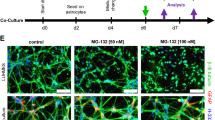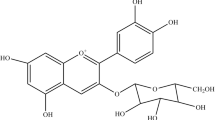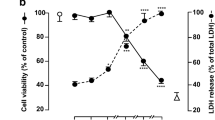Abstract
Ascorbic acid (AA), the reduced form of vitamin C, is incorporated into neurons via the sodium ascorbate co-transporter SVCT2. However, this transporter is not expressed in astrocytes, which take up the oxidized form of vitamin C, dehydroascorbic acid (DHA), via the facilitative hexose transporter GLUT1. Therefore, neuron and astrocyte interactions are thought to mediate vitamin C recycling in the nervous system. Although astrocytes are essential for the antioxidant defense of neurons under oxidative stress, a condition in which a large amount of ROS is generated that may favor the extracellular oxidation of AA and the subsequent neuronal uptake of DHA via GLUT3, potentially increasing oxidative stress in neurons. This study analyzed the effects of oxidative stress and DHA uptake on neuronal cell death in vitro. Different analyses revealed the presence of the DHA transporters GLUT1 and GLUT3 in Neuro2a and HN33.11 cells and in cortical neurons. Kinetic analyses confirmed that all cells analyzed in this study possess functional GLUTs that take up 2-deoxyglucose and DHA. Thus, DHA promotes the death of stressed neuronal cells, which is reversed by incubating the cells with cytochalasin B, an inhibitor of DHA uptake by GLUT1 and GLUT3. Additionally, the presence of glial cells (U87 and astrocytes), which promote DHA recycling, reverses the observed cell death of stressed neurons. Taken together, these results indicate that DHA promotes the death of stressed neurons and that astrocytes are essential for the antioxidative defense of neurons. Thus, the astrocyte-neuron interaction may function as an essential mechanism for vitamin C recycling, participating in the antioxidative defense of the brain.









Similar content being viewed by others
Abbreviations
- AA:
-
Ascorbic acid
- DHA:
-
Dehydroascorbic acid
- DMEM:
-
Dulbecco’s modified Eagle’s medium
- FBS:
-
Fetal bovine serum
- DOG:
-
Deoxyglucose
- GFAP:
-
Glial fibrillary acidic protein
- GLUT:
-
Glucose transporter
- GSH:
-
Glutathione
- IMDM:
-
Iscove’s modified Dulbecco’s medium
- PAGE:
-
Polyacrylamide gel electrophoresis
- PBS:
-
Phosphate-buffered saline
- ROS:
-
Reactive oxygen species
- SDS:
-
Sodium dodecyl sulfate
References
Carr AC, Frei B (1999) Toward a new recommended dietary allowance for vitamin C based on antioxidant and health effects in humans. Am J Clin Nutr 69:1086–107
Banhegyi G, Benedetti A, Csala M, Mandl J (2007) Stress on redox. FEBS Lett 581:3634–40
Li X, Huang J, May JM (2003) Ascorbic acid spares alpha-tocopherol and decreases lipid peroxidation in neuronal cells. Biochem Biophys Res Commun 305:656–61
May JM (1999) Is ascorbic acid an antioxidant for the plasma membrane? FASEB J 13:995–1006
Low M, Sandoval D, Aviles E, Perez F, Nualart F, Henriquez JP (2009) The ascorbic acid transporter SVCT2 is expressed in slow-twitch skeletal muscle fibres. Histochem Cell Biol 131:565–74
Bode AM, Cunningham L, Rose RC (1990) Spontaneous decay of oxidized ascorbic acid (dehydro-L-ascorbic acid) evaluated by high-pressure liquid chromatography. Clin Chem 36:1807–9
Halliwell B (2001) Vitamin C and genomic stability. Mutat Res 475:29–35
Linster CL, Van Schaftingen E (2007) Vitamin C. Biosynthesis, recycling and degradation in mammals. FEBS J 274:1–22
Wilson JX (2002) The physiological role of dehydroascorbic acid. FEBS Lett 527:5–9
Coyle JT, Puttfarcken P (1993) Oxidative stress, glutamate, and neurodegenerative disorders. Science 262:689–95
Astuya A, Caprile T, Castro M, Salazar K, Garcia Mde L, Reinicke K, Rodriguez F, Vera JC et al (2005) Vitamin C uptake and recycling among normal and tumor cells from the central nervous system. J Neurosci Res 79:146–56
Rice ME (2000) Ascorbate regulation and its neuroprotective role in the brain. Trends Neurosci 23:209–16
Wilson JX, Peters CE, Sitar SM, Daoust P, Gelb AW (2000) Glutamate stimulates ascorbate transport by astrocytes. Brain Res 858:61–6
Kim EJ, Park YG, Baik EJ, Jung SJ, Won R, Nahm TS, Lee BH (2005) Dehydroascorbic acid prevents oxidative cell death through a glutathione pathway in primary astrocytes. J Neurosci Res 79:670–9
Wells WW, Xu DP, Yang YF, Rocque PA (1990) Mammalian thioltransferase (glutaredoxin) and protein disulfide isomerase have dehydroascorbate reductase activity. J Biol Chem 265:15361–4
Nualart FJ, Rivas CI, Montecinos VP, Godoy AS, Guaiquil VH, Golde DW, Vera JC (2003) Recycling of vitamin C by a bystander effect. J Biol Chem 278:10128–33
Rumsey SC, Kwon O, Xu GW, Burant CF, Simpson I, Levine M (1997) Glucose transporter isoforms GLUT1 and GLUT3 transport dehydroascorbic acid. J Biol Chem 272:18982–9
Daskalopoulos R, Korcok J, Tao L, Wilson JX (2002) Accumulation of intracellular ascorbate from dehydroascorbic acid by astrocytes is decreased after oxidative stress and restored by propofol. Glia 39:124–32
Nualart F, Godoy A, Reinicke K (1999) Expression of the hexose transporters GLUT1 and GLUT2 during the early development of the human brain. Brain Res 824:97–104
Schulz (1994) Enzyme kinetics. University C, New York, pp 110–135
Mishell B, Shiigi S (1980) Transplantation of embryonic nerve tissue. In: Co. WHF (ed) Methods in cellular immunology, San Francisco
Mosmann T (1983) Rapid colorimetric assay for cellular growth and survival: application to proliferation and cytotoxicity assays. J Immunol Methods 65:55–63
Deves R, Krupka RM (1978) Cytochalasin B and the kinetics of inhibition of biological transport: a case of asymmetric binding to the glucose carrier. Biochim Biophys Acta 510:339–48
Castro M, Caprile T, Astuya A, Millan C, Reinicke K, Vera JC, Vasquez O, Aguayo LG et al (2001) High-affinity sodium-vitamin C co-transporters (SVCT) expression in embryonic mouse neurons. J Neurochem 78:815–23
Nelson JA, Falk RE (1993) Phloridzin and phloretin inhibition of 2-deoxy-D-glucose uptake by tumor cells in vitro and in vivo. Anticancer Res 13:2293–9
Rumsey SC, Daruwala R, Al-Hasani H, Zarnowski MJ, Simpson IA, Levine M (2000) Dehydroascorbic acid transport by GLUT4 in Xenopus oocytes and isolated rat adipocytes. J Biol Chem 275:28246–53
Meister A (1992) On the antioxidant effects of ascorbic acid and glutathione. Biochem Pharmacol 44:1905–15
Winkler BS, Boulton ME, Gottsch JD, Sternberg P (1999) Oxidative damage and age-related macular degeneration. Mol Vis 5:32
Daruwala R, Song J, Koh WS, Rumsey SC, Levine M (1999) Cloning and functional characterization of the human sodium-dependent vitamin C transporters hSVCT1 and hSVCT2. FEBS Lett 460:480–4
García L, Salazar K, Millan C, Rodriguez F, Montecinos H, Caprile T, Silva C, Cortes C et al (2005) Sodium vitamin C cotransporter SVCT2 is expressed in hypothalamic glial cells. Glia 50:32–47
Tsukaguchi H, Tokui T, Mackenzie B, Berger UV, Chen XZ, Wang Y, Brubaker RF, Hediger MA (1999) A family of mammalian Na+-dependent L-ascorbic acid transporters. Nature 399:70–5
Welch RW, Wang Y, Crossman A Jr, Park JB, Kirk KL, Levine M (1995) Accumulation of vitamin C (ascorbate) and its oxidized metabolite dehydroascorbic acid occurs by separate mechanisms. J Biol Chem 270:12584–92
Nagamatsu S, Kornhauser JM, Burant CF, Seino S, Mayo KE, Bell GI (1992) Glucose transporter expression in brain. cDNA sequence of mouse GLUT3, the brain facilitative glucose transporter isoform, and identification of sites of expression by in situ hybridization. J Biol Chem 267:467–72
Thoidis G, Kupriyanova T, Cunningham JM, Chen P, Cadel S, Foulon T, Cohen P, Fine RE et al (1999) Glucose transporter Glut3 is targeted to secretory vesicles in neurons and PC12 cells. J Biol Chem 274:14062–6
Uldry M, Ibberson M, Hosokawa M, Thorens B (2002) GLUT2 is a high affinity glucosamine transporter. FEBS Lett 524:199–203
Maher F, Vannucci SJ, Simpson IA (1994) Glucose transporter proteins in brain. FASEB J 8:1003–11
Nagamatsu S, Sawa H, Kamada K, Nakamichi Y, Yoshimoto K, Hoshino T (1993) Neuron-specific glucose transporter (NSGT): CNS distribution of GLUT3 rat glucose transporter (RGT3) in rat central neurons. FEBS Lett 334:289–95
Leino RL, Gerhart DZ, van Bueren AM, McCall AL, Drewes LR (1997) Ultrastructural localization of GLUT 1 and GLUT 3 glucose transporters in rat brain. J Neurosci Res 49:617–26
Morgello S, Uson RR, Schwartz EJ, Haber RS (1995) The human blood–brain barrier glucose transporter (GLUT1) is a glucose transporter of gray matter astrocytes. Glia 14:43–54
Boado RJ, Pardridge WM (1990) The brain-type glucose transporter mRNA is specifically expressed at the blood–brain barrier. Biochem Biophys Res Commun 166:174–9
Gerhart DZ, Leino RL, Borson ND, Taylor WE, Gronlund KM, McCall AL, Drewes LR (1995) Localization of glucose transporter GLUT 3 in brain: comparison of rodent and dog using species-specific carboxyl-terminal antisera. Neuroscience 66:237–46
White MK, Rall TB, Weber MJ (1991) Differential regulation of glucose transporter isoforms by the src oncogene in chicken embryo fibroblasts. Mol Cell Biol 11:4448–54
Ahmed N, Berridge MV (1999) N-glycosylation of glucose transporter-1 (Glut-1) is associated with increased transporter affinity for glucose in human leukemic cells. Leuk Res 23:395–401
Samih N, Hovsepian S, Notel F, Prorok M, Zattara-Cannoni H, Mathieu S, Lombardo D, Fayet G et al (2003) The impact of N- and O-glycosylation on the functions of Glut-1 transporter in human thyroid anaplastic cells. Biochim Biophys Acta 1621:92–101
Vera JC, Rivas CI, Fischbarg J, Golde DW (1993) Mammalian facilitative hexose transporters mediate the transport of dehydroascorbic acid. Nature 364:79–82
Halliwell B (2006) Oxidative stress and neurodegeneration: where are we now? J Neurochem 97:1634–58
Halliwell B, Whiteman M (2004) Measuring reactive species and oxidative damage in vivo and in cell culture: how should you do it and what do the results mean? Br J Pharmacol 142:231–55
Song JH, Shin SH, Chung IM (2002) Effects of glutamate on dehydroascorbate uptake and its enhanced vulnerability to the peroxidation in cerebral cortical slices. Exp Mol Med 34:419–25
Song JH, Shin SH, Ross GM (2001) Oxidative stress induced by ascorbate causes neuronal damage in an in vitro system. Brain Res 895:66–72
Hardaway CM, Badisa RB, Soliman KF (2012) Effect of ascorbic acid and hydrogen peroxide on mouse neuroblastoma cells. Mol Med Rep 5:1449–52
Chacon MR, Jensen MB, Sattin JA, Zivin JA (2008) Neuroprotection in cerebral ischemia: emphasis on the SAINT trial. Curr Cardiol Rep 10:37–42
Mack WJ, Mocco J, Ducruet AF, Laufer I, King RG, Zhang Y, Guo W, Pinsky DJ et al (2006) A cerebroprotective dose of intravenous citrate/sorbitol-stabilized dehydroascorbic acid is correlated with increased cerebral ascorbic acid and inhibited lipid peroxidation after murine reperfused stroke. Neurosurgery 59:383–8, discussion 383–8
Huang J, Agus DB, Winfree CJ, Kiss S, Mack WJ, McTaggart RA, Choudhri TF, Kim LJ et al (2001) Dehydroascorbic acid, a blood–brain barrier transportable form of vitamin C, mediates potent cerebroprotection in experimental stroke. Proc Natl Acad Sci U S A 98:11720–4
Ducruet AF, Mack WJ, Mocco J, Hoh DJ, Coon AL, D’Ambrosio AL, Winfree CJ, Pinsky DJ et al (2011) Preclinical evaluation of postischemic dehydroascorbic acid administration in a large-animal stroke model. Transl Stroke Res 2:399–403
Hediger MA (2002) New view at C. Nat Med 8:445–6
Wilson JX (1997) Antioxidant defense of the brain: a role for astrocytes. Can J Physiol Pharmacol 75:1149–63
Siushansian R, Wilson JX (1995) Ascorbate transport and intracellular concentration in cerebral astrocytes. J Neurochem 65:41–9
Corti A, Casini AF, Pompella A (2010) Cellular pathways for transport and efflux of ascorbate and dehydroascorbate. Arch Biochem Biophys 500:107–15
Wilson JX (2005) Regulation of vitamin C transport. Annu Rev Nutr 25:105–25
Matsuo Y, Kihara T, Ikeda M, Ninomiya M, Onodera H, Kogure K (1995) Role of neutrophils in radical production during ischemia and reperfusion of the rat brain: effect of neutrophil depletion on extracellular ascorbyl radical formation. J Cereb Blood Flow Metab 15:941–7
May JM, Qu ZC, Mendiratta S (1998) Protection and recycling of alpha-tocopherol in human erythrocytes by intracellular ascorbic acid. Arch Biochem Biophys 349:281–9
Cisternas P, Silva-Alvarez C, Martinez F, Fernandez E, Ferrada L, Oyarce K, Salazar K, Bolanos JP et al (2014) The oxidized form of vitamin C, dehydroascorbic acid, regulates neuronal energy metabolism. J Neurochem 129:663–71
Garcia-Nogales P, Almeida A, Bolanos JP (2003) Peroxynitrite protects neurons against nitric oxide-mediated apoptosis. A key role for glucose-6-phosphate dehydrogenase activity in neuroprotection. J Biol Chem 278:864–74
Song JH, Shin SH, Ross GM (1999) Prooxidant effects of ascorbate in rat brain slices. J Neurosci Res 58:328–36
Siushansian R, Tao L, Dixon SJ, Wilson JX (1997) Cerebral astrocytes transport ascorbic acid and dehydroascorbic acid through distinct mechanisms regulated by cyclic AMP. J Neurochem 68:2378–85
Wilson JX, Dixon SJ (1995) Ascorbate concentration in osteoblastic cells is elevated by transforming growth factor-beta. Am J Physiol 268:E565–71
Siushansian R, Dixon SJ, Wilson JX (1996) Osmotic swelling stimulates ascorbate efflux from cerebral astrocytes. J Neurochem 66:1227–33
Evans MK, Tovmasyan A, Batinic-Haberle I, Devi GR (2014) Mn porphyrin in combination with ascorbate acts as a pro-oxidant and mediates caspase-independent cancer cell death. Free Radic Biol Med 68:302–14
Chen Q, Espey MG, Krishna MC, Mitchell JB, Corpe CP, Buettner GR, Shacter E, Levine M (2005) Pharmacologic ascorbic acid concentrations selectively kill cancer cells: action as a pro-drug to deliver hydrogen peroxide to tissues. Proc Natl Acad Sci U S A 102:13604–9
Tian W, Wang Y, Xu Y, Guo X, Wang B, Sun L, Liu L, Cui F et al (2014) The hypoxia-inducible factor renders cancer cells more sensitive to vitamin C-induced toxicity. J Biol Chem 289:3339–51
Vanden Berghe T, Linkermann A, Jouan-Lanhouet S, Walczak H, Vandenabeele P (2014) Regulated necrosis: the expanding network of non-apoptotic cell death pathways. Nat Rev Mol Cell Biol 15:135–47
Linkermann A, Skouta R, Himmerkus N, Mulay SR, Dewitz C, De Zen F, Prokai A, Zuchtriegel G et al (2014) Synchronized renal tubular cell death involves ferroptosis. Proc Natl Acad Sci U S A 111:16836–41
Carcamo JM, Pedraza A, Borquez-Ojeda O, Zhang B, Sanchez R, Golde DW (2004) Vitamin C is a kinase inhibitor: dehydroascorbic acid inhibits IkappaBalpha kinase beta. Mol Cell Biol 24:6645–52
Carcamo JM, Pedraza A, Borquez-Ojeda O, Golde DW (2002) Vitamin C suppresses TNF alpha-induced NF kappa B activation by inhibiting I kappa B alpha phosphorylation. Biochemistry 41:12995–3002
Swanson RA, Ying W, Kauppinen TM (2004) Astrocyte influences on ischemic neuronal death. Curr Mol Med 4:193–205
Acknowledgments
This work was supported by a grant from the Fondo Nacional de Ciencia y Tecnología (FONDECYT 1140477) to FN and Conicyt PIA ECM12. We thank Dr. Marjet Heitzer for critical reading and editing of the manuscript and Ms. Ximena Koch for technical support.
Author information
Authors and Affiliations
Corresponding author
Ethics declarations
All animals were handled in strict accordance with the Animal Welfare Assurance (permit number: 2010101A), and all animal work was approved by the Ethics and Animal Care and Use Committee of the University of Concepcion, Chile. Female adult Sprague–Dawley rats were used for the experiments and were kept under a 12-h light/dark cycle with food and water provided ad libitum.
Conflict of Interest
The authors declare that they have no competing interests.
Additional information
Andrea García-Krauss and Luciano Ferrada contributed equally to this work.
Rights and permissions
About this article
Cite this article
García-Krauss, A., Ferrada, L., Astuya, A. et al. Dehydroascorbic Acid Promotes Cell Death in Neurons Under Oxidative Stress: a Protective Role for Astrocytes. Mol Neurobiol 53, 5847–5863 (2016). https://doi.org/10.1007/s12035-015-9497-3
Received:
Accepted:
Published:
Issue Date:
DOI: https://doi.org/10.1007/s12035-015-9497-3




